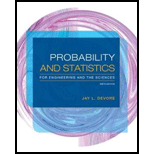
Concept explainers
Let α1 > 0, α2 > 0, with α1 + α2 = α. Then
- a. Use this equation to derive a more general expression for a 100(1 - α)% CI for μ of which the interval (7.5) is a special case.
- b. Let α = .05 and α1 = α /4, α2 = 3α/4. Does this result in a narrower or wider interval than the interval (7.5)?
a.
Derive the general expression for
Answer to Problem 8E
The general expression for
Explanation of Solution
Given info:
For
Calculation:
The usual
Here, it is given that with probability
General expression for confidence interval is obtained as follows:
From the obtained result, there is evidence to infer that with probability
Therefore, the
b.
Find the width of the usual confidence interval about mean for
Find the width of the confidence interval obtained in part (a) for
Compare the two confidence intervals.
Answer to Problem 8E
The width of the usual confidence interval about mean for
The width of the confidence interval obtained in part (a) for
The confidence interval obtained in part (a) for
Explanation of Solution
Calculation:
Width of usual confidence interval for
Critical value:
The level of significance is
From Table A.3 of the standard normal distribution in Appendix , the critical value corresponding to 0.05 area to the right is 1.96.
Thus, the critical value is
The usual
The general formula to obtain width of the interval is,
Thus, the width of the usual confidence interval about mean for
Width of usual confidence interval obtained in part (a) for
Critical value:
For
The level of significance is
From Table A.3 of the standard normal distribution in Appendix , the critical value corresponding to 0.0125 area to the right is 2.24.
Thus, the critical value is
For
The level of significance is
From Table A.3 of the standard normal distribution in Appendix , the critical value corresponding to 0.0375 area to the right is 1.78.
Thus, the critical value is
The
The general formula to obtain width of the interval is,
Thus, the width of the usual confidence interval for population mean
Comparison:
The width of the usual confidence interval about mean for
The width of the confidence interval obtained in part (a) for
By observing the two widths it can be concluded that, confidence interval obtained in part (a) for
Want to see more full solutions like this?
Chapter 7 Solutions
Probability and Statistics for Engineering and the Sciences
- If a baby's weight is at the median, what's her percentile?arrow_forwardAt the same restaurant as in Question 19 with the same normal distribution, what's the chance of it taking no more than 15 minutes to get service?arrow_forwardClint, obviously not in college, sleeps an average of 8 hours per night with a standard deviation of 15 minutes. What's the chance of him sleeping between 7.5 and 8.5 hours on any given night? 0-(7-0) 200 91109s and doiw $20 (8-0) mol 8520 slang $199 galbrog seam side pide & D (newid se od poyesvig as PELEO PER AFTE editiw noudab temand van Czarrow_forward
- Times to complete a statistics exam have a normal distribution with a mean of 40 minutes and standard deviation of 6 minutes. Deshawn's time comes in at the 90th percentile. What percentage of the students are still working on their exams when Deshawn leaves?arrow_forwardSuppose that the weights of cereal boxes have a normal distribution with a mean of 20 ounces and standard deviation of half an ounce. A box that has a standard score of o weighs how much? syed by ilog ni 21arrow_forwardBob scores 80 on both his math exam (which has a mean of 70 and standard deviation of 10) and his English exam (which has a mean of 85 and standard deviation of 5). Find and interpret Bob's Z-scores on both exams to let him know which exam (if either) he did bet- ter on. Don't, however, let his parents know; let them think he's just as good at both subjects. algas 70) sering digarrow_forward
- Sue's math class exam has a mean of 70 with a standard deviation of 5. Her standard score is-2. What's her original exam score?arrow_forwardClint sleeps an average of 8 hours per night with a standard deviation of 15 minutes. What's the chance he will sleep less than 7.5 hours tonight? nut bow visarrow_forwardSuppose that your score on an exam is directly at the mean. What's your standard score?arrow_forward
- One state's annual rainfall has a normal dis- tribution with a mean of 100 inches and standard deviation of 25 inches. Suppose that corn grows best when the annual rainfall is between 100 and 150 inches. What's the chance of achieving this amount of rainfall? wved now of sociarrow_forward13 Suppose that your exam score has a standard score of 0.90. Does this mean that 90 percent of the other exam scores are lower than yours?arrow_forwardBob's commuting times to work have a nor- mal distribution with a mean of 45 minutes and standard deviation of 10 minutes. How often does Bob get to work in 30 to 45 minutes?arrow_forward
- Algebra & Trigonometry with Analytic GeometryAlgebraISBN:9781133382119Author:SwokowskiPublisher:Cengage
 Trigonometry (MindTap Course List)TrigonometryISBN:9781337278461Author:Ron LarsonPublisher:Cengage Learning
Trigonometry (MindTap Course List)TrigonometryISBN:9781337278461Author:Ron LarsonPublisher:Cengage Learning
 Mathematics For Machine TechnologyAdvanced MathISBN:9781337798310Author:Peterson, John.Publisher:Cengage Learning,
Mathematics For Machine TechnologyAdvanced MathISBN:9781337798310Author:Peterson, John.Publisher:Cengage Learning,



